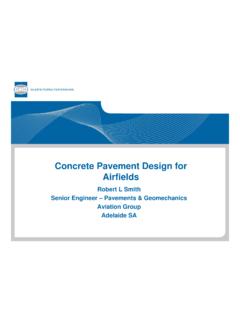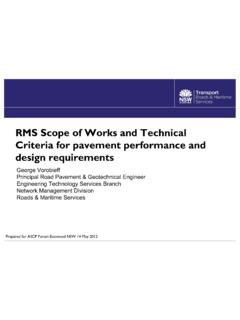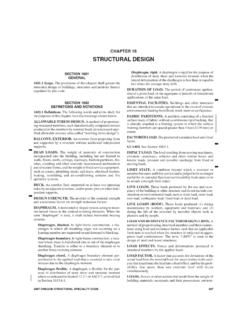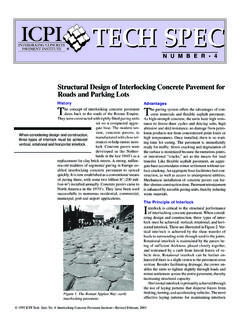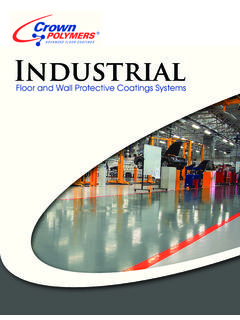Transcription of Design for Load Transfer in Industrial Concrete …
1 Presented by Bruce Ireland, B EngProduct Development ManagerDanley Construction Products Pty LtdDesign for load Transfer in Industrial Concrete pavement JointsConcrete Pavements ForumBrisbane 29thApril, 2009 Industrial pavements, for the purposes of this document are rigid pavements, and may be either: Jointed unreinforced Concrete pavements Jointed reinforced Concrete pavements Steel fibre reinforced Concrete pavements Post tensioned Concrete pavementsRecognized Design guides such as the Australian CCAA T48 or the Concrete Society Technical Reports TR34 and TR66 may be used to determine slab thickness, but you should be cautioned that they do have some shortcomings with regard to load transferThis Design methodology should not be used as the sole determination of slab thickness.
2 However, it may well be that load Transfer requirements are the controlling factor in determining slab thickness Introduction Concrete shrinks so dowels require sleeves that allow movement both perpendicular and parallel to the joint Concrete slabs curl, so perimeter of slab will be unsupported by sub-grade Slab Design needs to be based on edge loading condition Edge thickenings at joints should not be used There needs to be sufficient Concrete surrounding the dowels to resist the loads, or supplementary reinforcement may be required Select dowel systems with known characteristics [Note that rule-of-thumb Design may not be appropriate for the Design conditions]
3 Basis of designExtent of pour Isolation joints between slab and adjacent structures, column footings, machinery bases, pits, walls, etc Construction joints around the perimeter of each Concrete pour -placement is dictated by paving geometry, paving equipment, paving crew size and availability of Concrete Contraction joints to control random drying shrinkage cracking - position depends on paving geometry, Concrete type and mix, predicted Concrete shrinkage, intended use for facility, aesthetics, and judgement based on experience Not shown are expansion joints [usually construction joints]
4 In exterior pavementsWall of existing structureControlling drying shrinkage with jointsDesigns should allow for independent floating panelsSlab shrinkage dynamicsRestraintShrinkageIf the sleeve elements of the dowel system do not allow the dowel to moveparallel to the line of the joint , the resulting restraint will cause slab failureParticular care needs to be taken in the choice of an appropriate dowel system, so that these slab shrinkage effects are accommodatedThis is particularly important in post tensioned slabs with wide joints.
5 joint widths of say 35 mm need to a cater for 18 mm lateral movement Accommodating slab shrinkageRound dowelsIn Industrial pavement applications, where contractors want to place large areas of Concrete in each pour, with the least number of joints, round dowels consistently fail to perform as expected: Use of round dowels perpetuates 1940s technology when slabs were hand placed in 10 to 12 ft squares hence shrinkage effect was minimal There are no round dowel systems in the market that accommodate shrinkage parallel to the joint Are quite often poorly or incorrectly placed Induce higher stresses on Concrete than other types of dowels Are inefficient in load resistance and deflection properties compared to other dowel systemsIf you want to specify or use round dowels.
6 Space joints close together [3 to 4 m max] so that the effects of shrinkage parallel to the joint are minimised Use large aggregates in the mix [even 40 mm] to reduce the rate of curing shrinkage Use properly supported dowel sleeves in the first pour In sawn contraction joint applications, appropriate round dowel cradles shouldbe usedKey joints are suitable for lightly loaded applications only where height differential between slabs is of little importance. If the ( joint ) opening is greater than 1 mm, .. load Transfer by key ways.
7 Cannot be relied upon and ..an effective load Transfer device [should be] installed [CCAA T48: and ]The key on key joints begins at 1/3rdof the depth of the slab, and this where most failures originate keyed joints cause the adjacent Concrete to perform as if it were only 2/3rdsof its actual thickness [even when used with dowels] Key jointsAggregate interlockJoint effectiveness deteriorates with every load repetition, and becomes ineffective if joint opens more than 10 to 15% of the size of the largest grade of aggregate used [assuming that there are sufficient pieces of that size aggregate in the fracture plane!]
8 ] Also note that depth of sawcut reduces the area available for aggregate interlock to developIf the ( joint ) opening is greater than 1 mm, .. load Transfer by aggregate interlock ..cannot be relied upon and ..an effective load Transfer device [should be] installed [T48 ]Even with tied joints, the effectiveness diminishes over timeDowel systems for construction jointsDiamond DowelsSquare Dowels with either Dowelmaster Sleeves for 16 or 20 mm dowels or Flanged Dowel Boxes to suit dowels up to 40 mm squareDowel systems for sawn contraction joints6 mm or 10 mm PD3 Cradles or Plate Dowel Cradles Square Dowel Cradles with Dowelmaster Sleeves for 16 or 20 mm dowels or Metal Dowel Covers for dowels up to 40 mm Magnitude of loading Percentage of load to be transferred across the joint [must be 100% for loads rolling
9 Across joints] load repetitions Design Concrete strength Reinforcing in the slab [unreinforced, steel fibres, bar mats, etc] Slab thickness Projected joint width [anticipated slab shrinkage] Capacity of the Concrete at the load Transfer device Capacity of the load Transfer device [dowel steel capacity] Supplemental reinforcement at dowels Vertical differential movement that can be tolerated joint type construction, contraction, expansionDowel Design parametersWhat are the loads?While the uniform loads from stacked material may be high, the wheel loads on the material handling equipment may be more severe on the load Transfer dowels in the joints t on t on t on steer axle axle grouptri-axle groupSo for B-doubles, load per axle ranges from to tLegal loads on B-doublesBut even the humble delivery truck with dual wheel single axles may legally have tonne axle loads.
10 And the dowels in Concrete pavement joints need to be able to accommodate these loadsIt s not always the size that matters ..Axle load Distribution on Typical Counterbalanced Fork Lift Truck used for Container Handling Weight [tonnes]A x le L oa d [to n n es]Front AxleRear AxleThe forklift [left] lifting a 23 tonne gross weight container has a front axle loadof nearly 67 tonnes; the reach stacker [centre] can have drive axle loads up to 96 tonne; while the straddle carrier could have wheel loads of only 15 tonneAnd stacked loaded containers 4 high x 30 tonne each impart a load of 30 tonne on a 162 x 178 mm contact area Container handling terminalsWith equipment getting larger and larger, Design of dowelled joints for mine maintenance facilities requires close attention For example, the Komatsu WA1200 Mountain Mover wheel loader [below]
